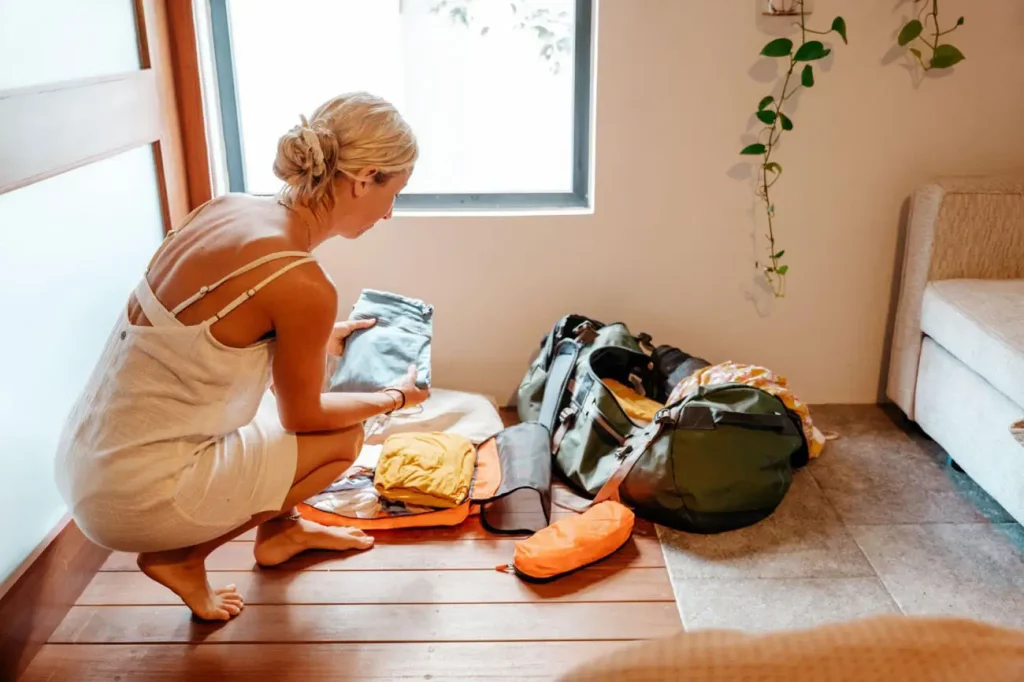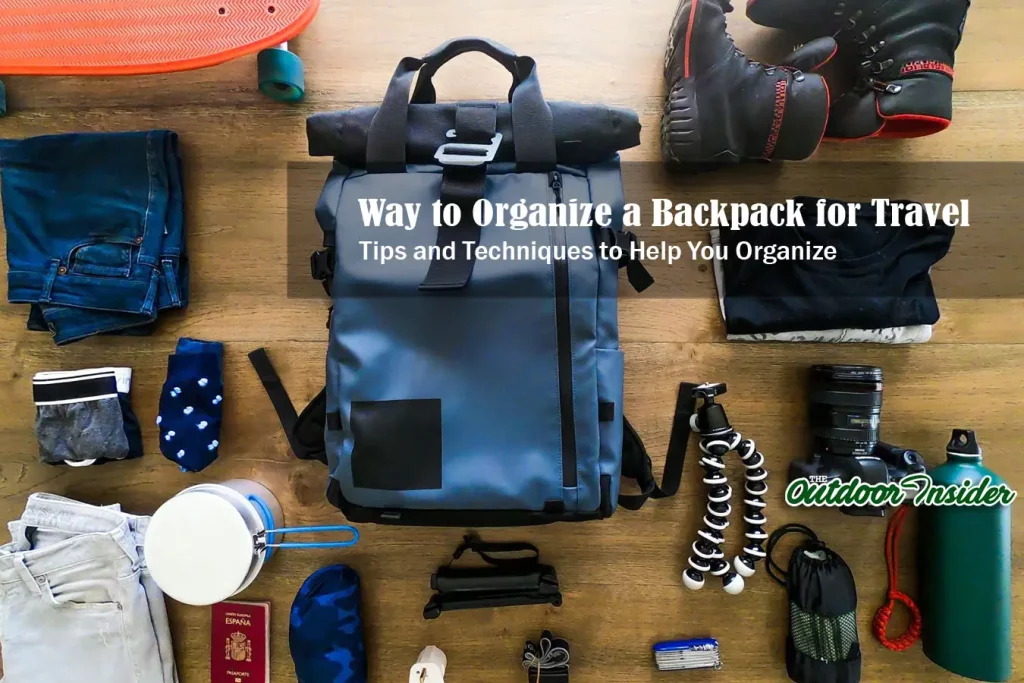Are you wondering how to organize a backpack for travel like a pro? Look no further!
Say goodbye to travel stress and hello to a seamlessly organized backpack that caters to all your travel needs.
Importance of Organizing Your Backpack for Travel
Packing your backpack the right way can change the whole game when you're on the move. Ever spent ages rummaging for that one item lost in a messy bag? Me neither, not since I figured out how to organize my stuff. When everything's in its place, your bag's weight spreads out evenly, saving your back during those long hikes.
And the best part? You can actually fit more in there without it turning into a black hole of clutter. Trust me, your future self will thank you!

Selecting the Right Backpack
Choosing the appropriate backpack is the first step towards efficient organization. Consider the duration and nature of your trip when selecting the size and style of the backpack. Opt for a backpack with multiple compartments and pockets to facilitate organization. Additionally, ensure that the backpack is comfortable, properly fits your body, and is made from durable materials to withstand the rigors of travel.
Essential Items to Pack in Your Backpack
Before diving into the packing process, it's essential to identify the key items you need to carry in your backpack. Categorize these items to simplify the organization process. Here are the main categories:
Clothing and Footwear
Start by packing versatile and lightweight clothing items suitable for the climate and activities of your destination. Include items such as t-shirts, pants, underwear, socks, and appropriate footwear. Remember to consider layering options for varying weather conditions.
Toiletries and Personal Care
Pack travel-sized toiletries, including toothbrush, toothpaste, shampoo, conditioner, soap, and any other personal care items you require. Place them in a waterproof toiletry bag to prevent leaks and keep them easily accessible.
Electronics and Gadgets
If you're carrying electronic devices, such as a smartphone, tablet, or laptop, ensure they are protected with padded sleeves. Don't forget to pack the necessary chargers, adapters, and power banks. Consider using a cable organizer to avoid tangling and make them readily available.
Travel Documents and Money
Keep your travel documents, such as passports, tickets, and travel insurance, in a secure and easily accessible compartment. Carry your money and cards in a travel wallet or a hidden pocket for added security.
Medications and First Aid
If you take any prescription medications, ensure you have an adequate supply for the duration of your trip. Pack a compact first aid kit with essential items like band-aids, pain relievers, and any other medications or supplies you might need.
Snacks and Water
Carry a few lightweight snacks for quick energy boosts during your journey. Fill a reusable water bottle to stay hydrated throughout your travels. Consider using a collapsible water bottle to save space when it's empty.
Entertainment and Comfort Items
Include items to keep you entertained and comfortable during long journeys, such as a book, headphones, travel pillow, and eye mask. These items can make your travel experience more enjoyable and help pass the time.
Know more: How to Pack a Backpack for Hiking
Efficient Packing Techniques
Now that you have your essential items sorted, let's delve into some efficient packing techniques to make the most of the available space in your backpack for organize a backpack for travel.
Roll or Fold Method
When packing clothing items, consider either rolling or folding them neatly. Rolling clothes saves space and minimizes wrinkles, while folding them creates a neater appearance. Experiment with both methods and use the one that suits your preferences.
Use Packing Cubes or Compression Bags
Invest in packing cubes or compression bags to compartmentalize your belongings further. These handy accessories help you organize items based on category or frequency of use, making it easier to locate them within your backpack.
Maximize Space with Layering
Place heavier and bulkier items at the bottom of your backpack, closer to your back, to distribute the weight evenly. Layer clothing items to fill any gaps and utilize the available space efficiently.
Utilize Empty Spaces
Make use of any empty spaces within your backpack. For example, stuff socks or small clothing items inside shoes, or tuck smaller items into the gaps between larger ones. Be creative in finding ways to utilize every inch of space.
Organizing the Main Compartment
The main compartment of your backpack is where the bulk of your belongings will be stored. To keep it organized and easily accessible, follow these tips to organize a backpack for travel:
Separating Clothes by Category
Group similar clothing items together and place them in separate packing cubes or compartments. This organization method makes it simpler to locate specific items without disturbing the entire contents of your backpack.
Utilizing Packing Cubes or Compression Bags
Utilize packing cubes or compression bags to further organize your clothes. Group them based on type or frequency of use. For example, you can have separate cubes for tops, bottoms, undergarments, and sleepwear.
Positioning Heavier Items at the Bottom
To ensure optimal weight distribution and balance, place heavier items, such as shoes or toiletry bags, at the bottom of your backpack. This arrangement prevents the backpack from becoming top-heavy and uncomfortable to carry.
Utilizing Backpack Pockets and Compartments
Most backpacks come with additional pockets and compartments, and utilizing them effectively can enhance your organization. Here are some suggestions for organize a backpack for travel:
Front Pocket for Quick Access Items
Designate the front pocket of your backpack for items you need to access frequently, such as your smartphone, wallet, or travel documents. This arrangement saves time and eliminates the need to dig through the main compartment.
Side Pockets for Water Bottles or Umbrellas
If your backpack has side pockets, utilize them for storing items like water bottles, umbrellas, or small snacks. These items will be easily accessible without taking up valuable space in the main compartment.
Hidden Pockets for Valuables
Many backpacks have hidden pockets located on the back panel or inside flaps. These pockets provide a discreet and secure location to store valuable items like your passport, cash, or credit cards. Take advantage of these hidden pockets to keep your valuables safe.
Securing and Protecting Your Backpack
Keeping your backpack secure and protecting its contents is essential while traveling. Follow these tips to ensure the safety of your belongings while organizing a backpack for travel:
Locking Zippers and Using TSA-Approved Locks
Invest in a reliable lock to secure the zippers of your backpack. This precaution helps deter theft and ensures that your belongings remain safe during your journey. If you're traveling by air, use TSA-approved locks that can be easily opened by airport security if required.
Protecting Electronics with Padded Sleeves
Electronics like laptops and tablets are vulnerable to damage during travel. Use padded sleeves or cases to protect them from bumps and scratches. Place these devices in a dedicated compartment within your backpack to avoid any accidental damage.
Using Rain Covers or Dry Bags
If you're traveling to a destination with unpredictable weather or plan to engage in outdoor activities, consider using a rain cover or a dry bag to protect your backpack from moisture. These protective covers shield your belongings from rain or accidental spills.
Distributing Weight and Balancing the Load
For optimal comfort, distribute the weight evenly throughout your backpack. Adjust the straps and hip belt to ensure a balanced load, reducing strain on your shoulders and back.
Adjusting and Customizing Your Backpack
Once your backpack is packed, take a moment to adjust the straps and customize the fit. Proper adjustment will enhance comfort during long hours of travel and reduce the risk of strain or injury.
Tips for Long-Term Travelers
If you're embarking on a long-term trip, consider packing versatile clothing items that can be mixed and matched. Also, periodically reorganize your backpack to maintain order and reevaluate the items you need.
Maintaining an Organized Backpack During Travel
While on the road, it's essential to maintain the organization of your backpack. Here are some tips to help you keep your backpack neat and functional throughout your journey:
Regularly Reorganizing and Decluttering
Take a few minutes each day to reorganize your backpack. Remove any items you no longer need or use and declutter your packing cubes or compartments. This habit prevents unnecessary bulk and makes it easier to find items when you need them.
Properly Folding and Storing Used Items
After using an item, fold it neatly and return it to its designated place. Avoid throwing used items haphazardly into your backpack, as this can create a disorganized mess and make it challenging to locate things later.
Maintaining a Clean and Odor-Free Backpack
Keep your backpack clean and fresh by occasionally wiping the interior with a damp cloth or using an antibacterial spray. Avoid storing dirty or damp clothes inside your backpack, as they can lead to unpleasant odors and potentially damage other items.
FAQs About Organize a Backpack for Travel
Can I bring a laptop in my backpack?
Should I pack a travel towel?
How many sets of clothes should I pack?
Can I bring liquids in my backpack?
Is it necessary to pack a first aid kit?
Conclusion
Now that you know how to organize a backpack for travel, don't forget to share the article if you find it useful. Organizing your backpack for travel is a skill that can greatly enhance your overall travel experience. By following the tips and techniques outlined in this article, you can efficiently pack your belongings, maximize space, and easily locate items during your journey. A well-organized backpack ensures that you have everything you need at your fingertips, allowing you to focus on enjoying your adventures without unnecessary stress or hassle.


